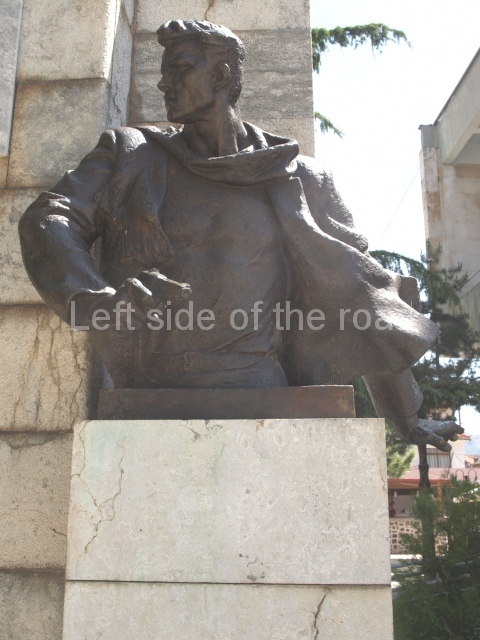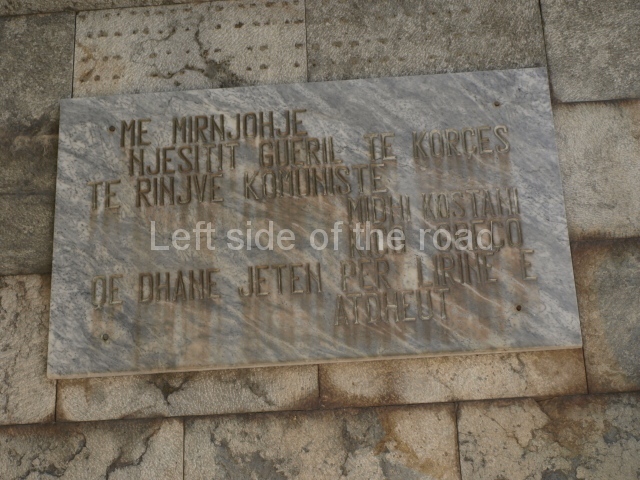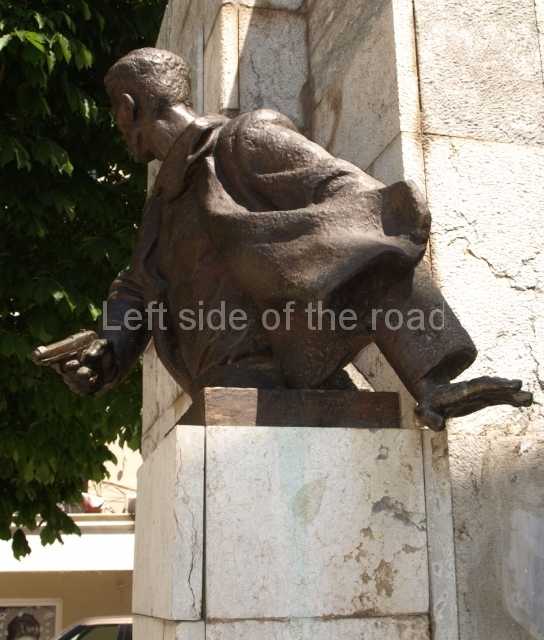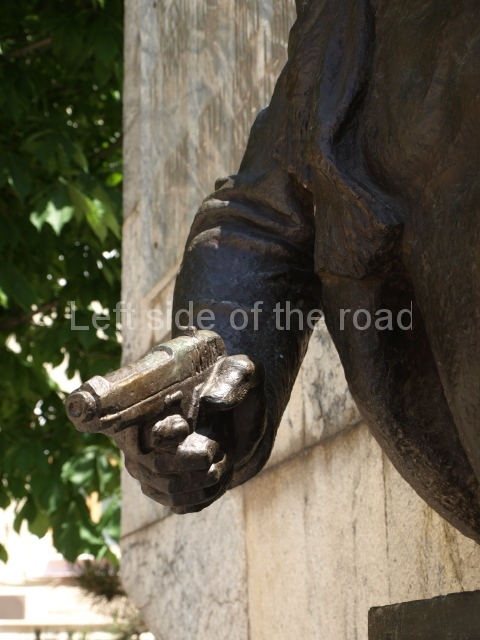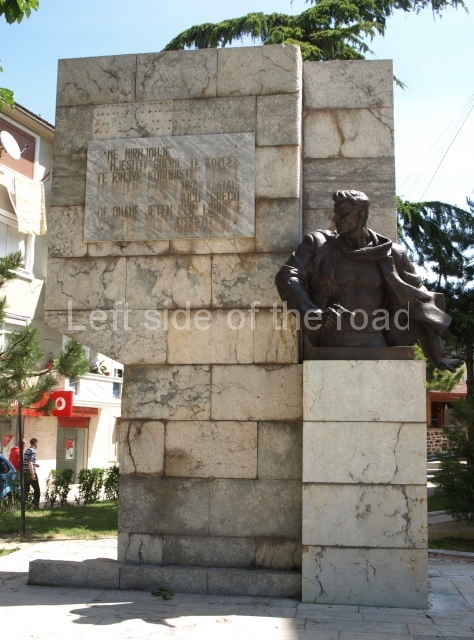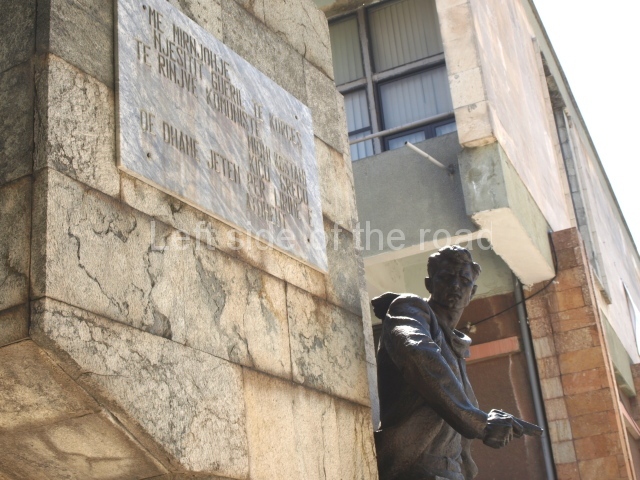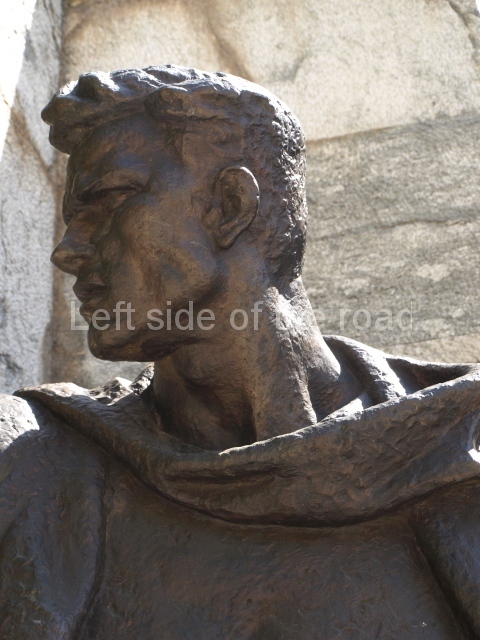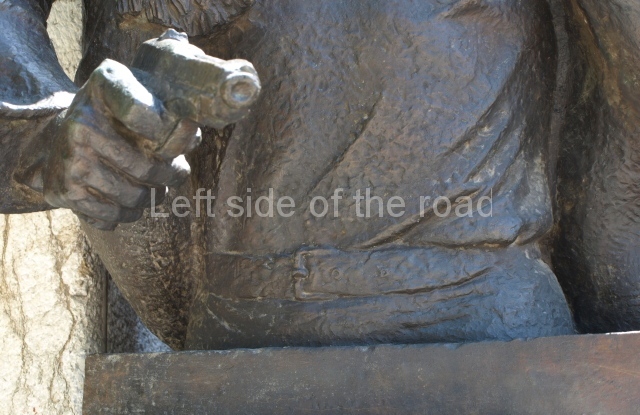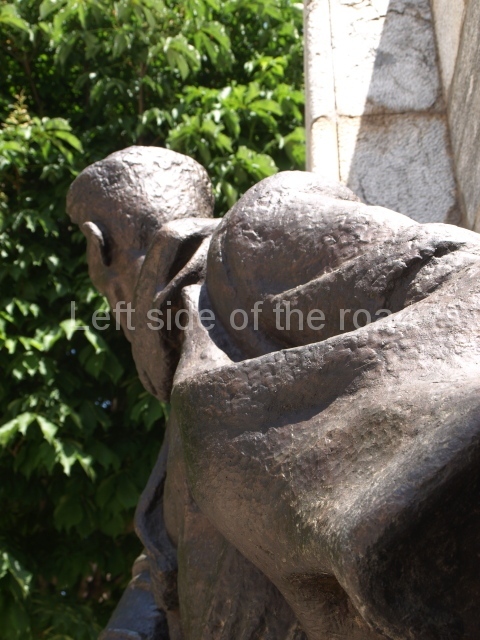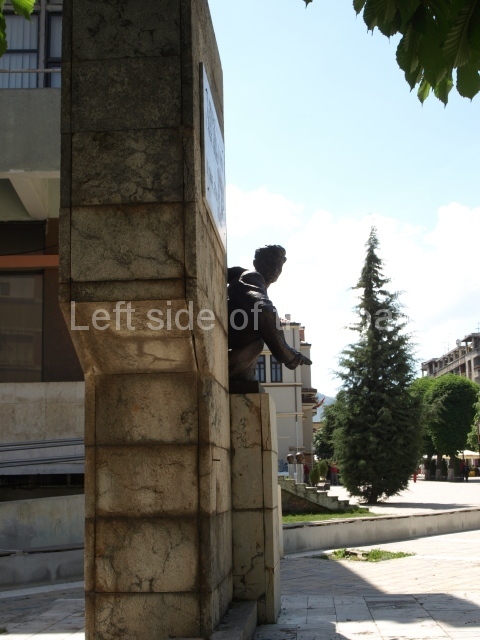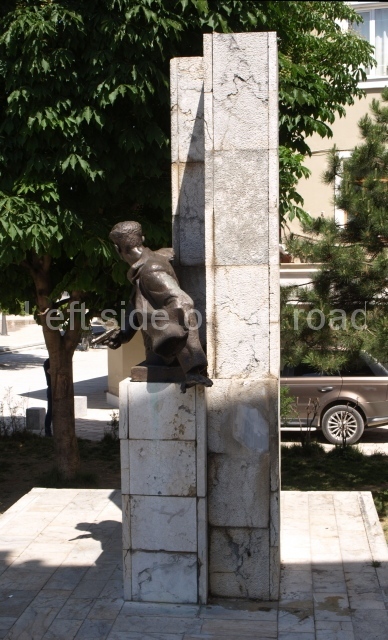
Martyrs’ Cemetery, Korçë
More on Albania …..
Martyrs’ Cemetery, Korçë
Many of the martyrs’ cemeteries in Albania are situated on hills above the towns and villages and this is certainly the case with the Martyrs’ Cemetery, Korçë, where the highest point is a fair hike from the centre of the town below. However, it’s worth the effort as, on a clear day, you have a fine view of the town, the fertile valley below and the mountains to the west as well as a fine example of Socialist Realist Art.
At the very top of the steps, with the tombs of the fallen partisans fanned out on either side of him, is a large statue of a male Partisan. Throughout the country there are a number of Martyrs’ Cemeteries that include such a stand alone, bronze statue. These include Ersekë, with yet another single male Partisan; Librazhd, where the statue is of a male and female; Lushnje, with a very charming statue of a kneeling female Partisan with a young boy; and Pogradec, where there is a group of three, two males and one female.
The statue is about twice life-size and he stands with his feet slightly apart, on top of a concrete plinth. He is dressed in the uniform of a partisan and wears a cap with the star on the front. Around his neck is a tied bandana – so, as is often the case, declaring his status as a Communist. On the belt around his waist there are three ammunition pouches (of five bullets each) in sight. On his feet he is wearing shoes rather than boots but as added protection against the elements he is wearing long, thick socks into which the bottom of his trousers are tucked, the sock reaching just to below his knees.

Martyrs’ Cemetery, Korçë
His left arm is stretched up to its full extent above him and the fist is clenched. This, to me, is the authentic Communist salute. His right arm is bent at 90 degrees and his right hand is tightly gripping the top part of the barrel of his rifle. This is a bolt-action rifle and the butt is resting on the ground, just before his right foot. He is looking down on the town of Korçë and into the distance where, at this height, it’s possible to see the mountains of Skrapar.
At the end of 2011 the general area of the cemetery, including the stepped approach was in a sad state. This included the statue, showing signs of wear and noticeable marks on the surface of the bronze. As with many of the Albanian lapidars there has been quite considerable renovation in the last year or so and the result of this is that the statue has had a very recent coating of gold paint.
The sculpture is the work of Avni Bilbili, Piro Dollaku and Ilia Xhano and was created in 1969. That’s early in the construction of Albanian lapidars and the Cultural Revolution. It was very common for there to have been a plaster statue in place initially, with a bronze statue coming later. I have not, so far, seen any pictures which indicate that in Korçë.
The only information I have about Avni Bilbili is that he is the creator of a monument to Naim Freshëri in Rruga Nëntori 28, in Korçë, in 1956.
Piro Dollaku and Ilia Xhano were joint creators of the magnificent Partisan and Child in Borovë. This sculpture, now beside the main road going through the village, used to be part of the main lapidar for the Borovë Martyr’s Cemetery, on the hill across the road. This was substantially remodeled but their bas-relief is now at the entrance gates to the cemetery.
Behind him are two, low, one-storey, rectangular buildings. The space between them is directly behind the statue. These are locked and it’s not, as far as I know, possible to go inside. As was the norm in Martyrs’ Cemeteries these would have been the small, local museum, displaying artefacts and photos from the National Liberation War.
As you look at the front of the statue the building on the left has the slogan; Lavdi Deshmoreve te Atdheut, which translates as; Glory to the martyrs of the homeland. This was the situation in May 2015. On my previous visit at the end of 2011 there was a ‘t’ at the end of ‘deshmoreve’. Today it’s still possible to see the shadow of the missing letter on the wall. I’ve been told that the ‘t’ is a more archaic grammatical form (although this is the first time I’ve come across this in all the places I’ve visited over the years) so this could be an updating of the term and, if done consciously, would have been part of the recent renovation.
On the wall of the building to the right there are 122 marble plaques. Each plaque has a name and two dates, the year of birth and death. I assume these are the names of those whose tombs are in the cemetery, the number would seem to correspond to that.
Although it’s difficult to get a feel when in the cemetery itself, standing beside the statue which is exactly in the centre, the tombs fan out on either side, somewhat like wings, spreading backwards. However, as part of the renovation an information board has been placed at the bottom of the main approach steps and here there’s a picture taken from the air.

Korca Martyrs’ Cemetery – information
The tombs have also been renovated. New marble replacing many broken slabs and the letters of the names of the Partisans being picked out in gold paint. They now look quite smart and being accorded the dignity they deserve. One thing that’s different from most of the cemeteries I’ve been to is that there are no stars on the tombs. On my 2015 visit I thought this was a consequence of the renovation (this eradication of the stars and the re-writing of history being evident in a number of places, such as the Saranda Martyrs’ Cemetery) but on checking my 2011 photos I find that they were missing then, although at that time I wasn’t that conscious of the norms throughout the country and so wasn’t looking as closely as I have developed of late.
And the whole area of the cemetery itself is much cleaner than a few years ago. There’s a tarmacked road just below the final flight of steps and all above that road has been cleaned up and repaired. The walls have been painted and the steps renewed. Below the road the steps are as they have been for a number of years, overgrown and the concrete breaking up, although there are signs that work was started to improve the area (but not completed) at the very start of the long trek uphill.
Extirpation of idolatry
Many Martyrs’ Cemeteries in Albania are built on hills. It’s a place of honour and also a reference to the fact that much of the fighting between 1939 and 1944 took place in the hills and mountains of the country. The hill in Korçë is close to the town itself and isn’t the highest in the immediate vicinity. Just to the south-east of the cemetery you can see a large, white cross on the top of a higher mountain, close enough to the town to be seen from the streets below.

Korca Martyrs’ Cemetery and white cross
You will see many of these if you travel around the country, normally on high points that can be seen for miles around. This is very reminiscent of the policy of the Catholic Church in many parts of the world. When the Spanish invaded Latin America in the late 15th and early 16th centuries they followed what they called a policy of the ‘extirpation of idolatry’. This resulted in the physical destruction or assimilation of any religious location encountered throughout the continent.
In Peru, where a special rock, tree, spring or any other natural phenomenon could have religious significance, this meant that those natural locations would be destroyed. The later building of a church was seen as sticking a knife into the heart of the indigenous culture. In 1988, just before Karol Wojtyla, the then head of the Catholic Church, was due to visit the country a large, white cross was erected on the hillside above the Andean city of Cusco. It was on this hill that the massive Incan temple of Sacsayhuaman used to be located, before being destroyed by the Spanish. This was a modern version of the ‘extirpation’.
It seems that the Catholic Church is still at it in Albania.
Location:
The cemetery is at the top of a hill to the east of the city centre. Go north along Bulevardi Republika, passing the monument to the demonstration against the Italian Fascists on the right and then turn right along narrow, cobbled Rruga Sotir Mero. At the top of the street go up the steps which take you to a small road, go left and then take the steep steps going up on your right. This is where the information plaque can be found.
GPS:
40.61886496
20.78970904
DMS:
40° 37′ 7.9139” N
20° 47′ 22.9525” E
Altitude:
961.8m
More on Albania ……




